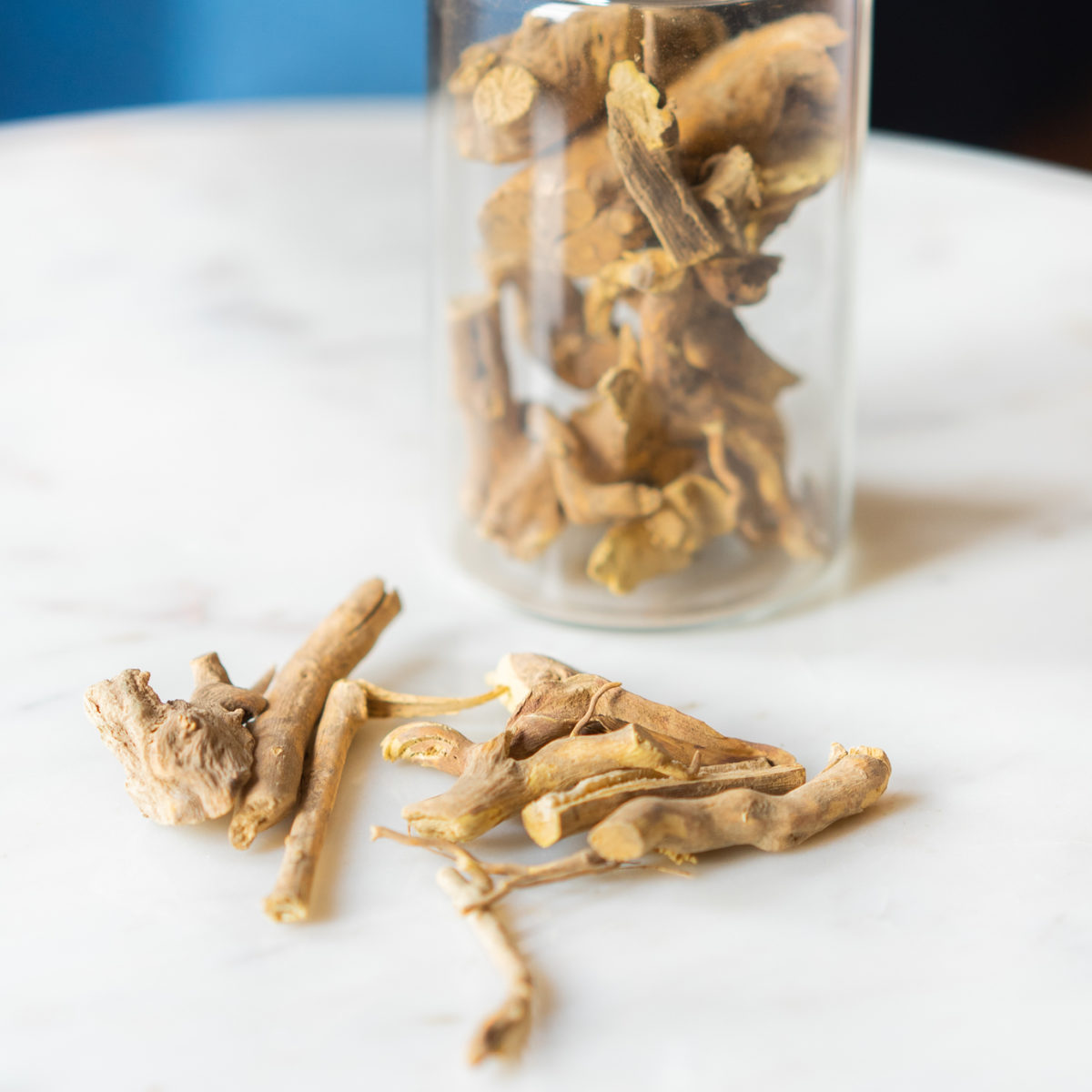
COMMON NAME (Chinese Name)
Dichroa; Blue Evergreen Hydrangea (Cháng Shān)
BOTANICAL NAME
Dichroa Febrifuga
USES
Dichroa, commonly called Blue Evergreen Hydrangea, is not a beginner’s herb. The most popular use of Dichroa is as an antimalarial decoction made of the wine-fried form of the root. While its efficacy in truly preventing and treating malaria in humans is still under-proven, there is significant anecdotal and empirical evidence of its anti-febrile properties. We know that Febrifugine, an alkaloid isolated from Dichroa febrifuga , is an active component against Plasmodium falciparum, the malaria parasite. Strong liver toxicity has precluded febrifugine as a potential clinical drug. There is also some study into its expectorant and emetic properties, as some of the other most common historical uses of Dichroa include helping alleviate the symptoms of respiratory infections and asthma.
Consequently, Dichroa root decoctions themselves (not the isolated/synthesized febrifuge that can be derived from the herb) may owe much of their reported antimalarial effects to this combination of anti-febrile and expectorant properties. Fever and an accumulation of fluid in the lungs are among the primary symptoms of malaria, so drinking tea that reduces fever and helps manage these respiratory symptoms likely does cause significant noticeable improvements in patients’ conditions.
Dichrora is categorized as an anti-parasite herb in Chinese medicine and has been combined with sweet wormwood to fight malaria. It is classified as cold, bitter, acrid, and toxic and especially affects the Lung, Heart and Liver meridians.
Outside of antimalarial uses, Dichroa tea can help reduce the symptoms and discomfort associated with coughs and fever-causing infections.
PREPARATION & ADMINISTRATION
The roots of Dichroa plants are involved in the creation of a variety of different herbal supplements, including powders, capsules, and tinctures but most are in formulas. The most common administrations call for using the whole, dried, wine-fried roots in a decoction or infusion (tea), as some other kinds of cooking can diminish its medicinal effects.
PRECAUTIONS
There’s relatively little information available about safe and appropriate dosing for Dichroa root or its derivatives, and also about the methods of its activities in humans. As a result, we don’t know much about its potential side-effects, interactions, or contraindications. When considering its derivatives/components, alone, febrifuge (its antimalarial and emetic agent) has not been approved for clinical use in humans, as it has intense emetic effects and can cause liver damage. That said, healthy adults should still exercise caution when taking Dichroa or adding it to an herbal regimen under the direction of a trained TCM practitioner.. What’s more, people who have chronic illnesses, are taking medications, or are pregnant should not take Dichroa without first talking to their doctor.
You should consult with a certified herbalist, physician or other qualified healthcare professional before taking Dichroa.
REFERENCES
Chen, John, Chen, T & Cramton, L. Art of Medicine Press, Inc. City of Industry, CA USA. 2003. 1327 pp ISBN: 0-9740635-0-9 , http://aompress.com/herbology
Mazzio, Elizabeth A., and Karam F. A. Soliman. “In Vitro Screening of Tumoricidal Properties of International Medicinal Herbs: Part II.” Phytotherapy Research, vol. 24, no. 12, 2010, pp. 1813–1824., doi:10.1002/ptr.3191.
Muthamilselvan, Thangarasu, et al. “Herbal Remedies for Coccidiosis Control: A Review of Plants, Compounds, and Anticoccidial Actions.” Evidence-Based Complementary and Alternative Medicine, vol. 2016, 2016, pp. 1–19., doi:10.1155/2016/2657981.
Park, Sun Young, et al. “Dichroa Febrifuga Lour. Inhibits the Production of IL-1β and IL-6 through Blocking NF-ΚB, MAPK and Akt Activation in Macrophages.” Journal of Ethnopharmacology, vol. 125, no. 2, 2009, pp. 246–251., doi:10.1016/j.jep.2009.07.003.
Rasoanaivo, Philippe, et al. “Whole Plant Extracts versus Single Compounds for the Treatment of Malaria: Synergy and Positive Interactions.” Malaria Journal, vol. 10, no. S1, 2011, doi:10.1186/1475-2875-10-s1-s4.
Taylor, Walter R.j., et al. “Respiratory Manifestations of Malaria.” Chest, vol. 142, no. 2, 2012, pp. 492–505., doi:10.1378/chest.11-2655.
Zhu, Shuren, et al. “Synthesis and Evaluation of Febrifugine Analogues as Potential Antimalarial Agents.” ChemInform, vol. 37, no. 28, Nov. 2006, doi:10.1002/chin.200628191.
